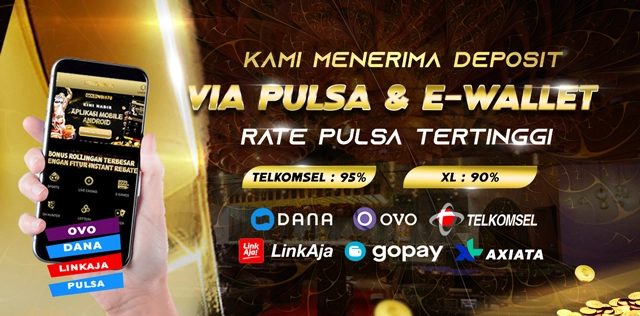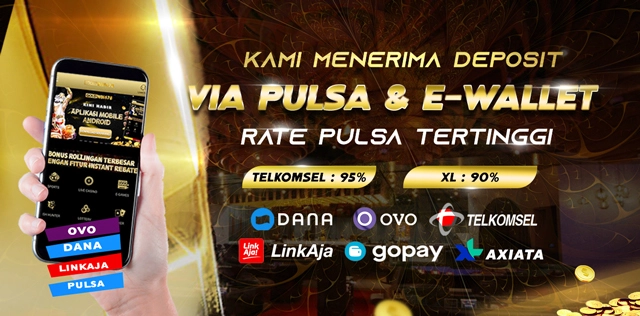QQSlot Online Goldwin678
GOLDWIN678: Daftar Situs Game Terlengkap Top #1 Sensasional
GOLDWIN678: Daftar Situs Game Terlengkap Top #1 Sensasional
Halo bosku, Selamat datang di Official Resmi Situs GOLDWIN678. Disini adalah tempat bermain game online terbaik dan terlengkap di tahun 2024, permaianan yang mudah menang dan gampang mendapatkan sensasional setiap harinya. Mari bergabung dan mainkan game serunya sekarang juga! Rasakan kenyamanan bermain game online gampang menang dan juga keuntungan lainnya di link situs resmi terpercaya GOLDWIN678.
Tersedia Beragam Metode Transaksi Terlengkap di GOLDWIN678
Disini kami akan memberitahukan beberapa metode transaksi pembayaran yang tersedia di situs resmi goldwin678 yang bisa kalian gunakan saat ingin bermain dan mencoba kegacoran disitus kami. Sebelum kami melanjutkan penjelasan tentang metode transaksi pembayaran disitus ini, tentunya kalian harus memiliki akun terlebih dahulu di situs resmi GOLDWIN678 untuk bisa login dan bermain semua permainan yang tersedia disini. Bagi kalian yang belum memiliki user akun, bisa langsung daftar di link resmi Goldwin678. Yuk disimak langsung apasaja metode transaksi pembayaran yang bisa kalian gunakan diantaranya:
Transaksi Via Bank
Goldwin678 menyediakan berbagai transaksi transfer via bank yang dapat kalian gunakan untuk deposit atau pengisian kredit, antara lain seperti Bank BCA, BRI, Mandiri, BNI, BSI dan CIMB Niaga. Metode ini bisa digunakan dengan cara transfer via mobile maupun setor tunai melalui mesin ATM.
Transaksi E-Walet
Semakin berkembangnya zaman pada saat ini telah banyak sekali bermunculan berbagai transaksi digital yang bisa orang-orang gunakan menjadi salah satu metode pembayaran dan transaksi dengan mudah selain menggunakan bank transfer. Disitus GOLDWIN678 sudah menerima pembayaran transaksi digital melalui E-walet yang mencakup DANA, OVO, Link Aja, Gopay, dll. Dengan metode e-walet ini pastinya akan mempermudah kalian yang ingin melakukan deposit tanpa harus susah payah ke bank untuk setor tunai lagi.
Transaksi Deposit Pulsa
Metode pembayaran menggunakan pulsa merupakan salah satu deposit paling gampang dan tidak ribet bagi kalian, karena hanya dengan mengirim pulsa atau pembelian melalui M-Kios tergantung provider apa yang kalian ingin gunakan sebagai pembayaran. Disini tersedia banyak sekali provider terbaik paling top di indonesia buat kalian semua yang ingin melakukan deposit pulsa diantaranya seperti provider ternama Telkomsel, XL, AXIS dan juga Tri.
Pembayaran Scan QRIS
Metode pembayaran QRIS merupakan transaksi yang sangat simple dan paling gampang digunakan untuk deposit, hanya cukup scan barcode yang disediakan oleh situs kami setelah itu dana deposit kalian akan otomatis masuk ke Akun paling lama 1 menit saja. Banyak sekali member kami menggunakan metode ini sebagai transaksi deposit yang gampang dan tidak ribet, hanya dengan scan barcode dan tentukan nominal deposit yang diinginkan abis itu dana akan langsung masuk ke akun kalian.
Tutorial Cara Deposit di Situs Resmi GOLDWIN678
Setelah kalian mengetahui apasaja metode pembayaran yang tersedia disitus GOLDWIN678, sekarang sudah saatnya kalian mengetahui juga bagaimana cara melakukan depositnya. Kami akan memberikan tutorial singkat yang mudah untuk dipahamin oleh kalian. Langsung saja tanpa basa basi lagi:
1. Pertama-tama kalian login dahulu kedalam akun kalian.
2. Setelah itu silahkan pencet/tekan menu deposit yang ada di bawah kiri kolom ke dua.
3. Selanjutnya pilih metode pembayaran yang diinginkan
4. Setelah itu isi nominal yang ingin di deposit oleh kalian. Sebagai contoh jika kalian melakukan deposit 50.000 maka cukup isi form depositnya sebesar nominal 50 saja.
5. Upload bukti transfer pembayaran yang sudah kalian depositkan
6. Klik tombol SUBMIT
Setelah langkah-langkah ini sudah kalian ikutin dengan benar maka tinggal tunggu 1-2 menit deposit akan masuk ke akun kalian dan bisa langsung memilih permainan apa saja yang ingin kalian mainkan. Terima kasih sudah mempercayakan taruhan kalian bersama kami semoga penjelasan singkat ini bisa berguna dan membantu kalian saat ingin bermain di GOLDWIN678.


